- Your School Type
- Solutions
- Resources
- Blog
- Events
- More
- Contact Us
- Book a Demo
- Get a Quote

COVID-19 turned the world upside down; uncertainty and social unrest became the new normal. Cities, indeed whole countries, went into lockdown, creating a great divide - isolating people and cutting them off from important support networks.
For schools, there was the uncertainty of whether or not they would be open from one day to the next. There was a scramble to implement online learning and find appropriate resources for this new mode of education. There was an uncertainty of rules, expectations, and best practice to keep staff and students safe
We recently partnered with SLA to conduct the 2020 School Library Survey UK which asked a range of questions, including some surrounding the impacts of COVID-19 on the school library.
It is important to note that the survey was conducted at the end of 2020, before schools went back into lockdown.
According to the survey, 7% of participants reported that the school library was closed completely, 4% reported being closed with click and collect.
18% of participants reported that their library was repurposed as a staff room, classroom, or intervention room.
60% of respondents reported that their libraries were open to a bubble or limited group. Many schools reporting that they were open to a bubble or group explained that they had a rota to allow different groups into the library at different times.
Further, there was a rise in classroom libraries, or book trolleys being delivered to classrooms, and click and collect was implemented to continue to connect students with reading.
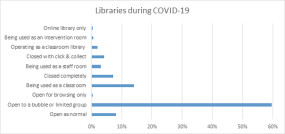
The following charts break down these responses by school type and education provider:
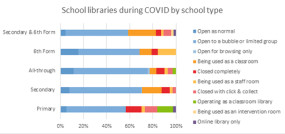
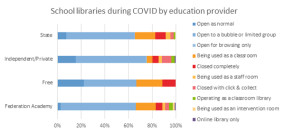
The statistics only tell some of the story. Comments made in the survey reveal a much bigger picture of the impact of COVID on school libraries.
Many respondents shared their concerns about the impact limiting access to the library would have on students.
Common concerns centred around the role of the library and staff to provide support to vulnerable students, to provide access to resources for disadvantaged students, to provide a social space, and to promote reading engagement.
“I feel that the vital role which the library plays in offering a refuge or safe space for pupils who are struggling has not been available for those who need it most - and with the anxiety surrounding the current situation this is likely to be affecting more children than usual. Children and young people's mental health will certainly suffer as a result and there may be a tendency for children to fall through the gaps and for worrying behaviour to go unnoticed.”
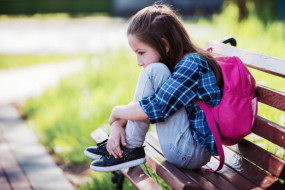
“The library is closed to students, even the computers, so if a student doesn't have one at home they are at a disadvantage.”
“Before COVID, the higher years could mix in the library with the lower years which provided a great opportunity for reading role models. It has been sad to see this withdrawn, as such mixing has huge benefits towards building our reading community.”
“It is sad to see the students that were great readers and used the library daily as a quiet space less engaged with reading.”
“Lunch time clubs and after school clubs are currently cancelled (due to library location and bubbles), meaning that students have lost their safe space to engage socially with others of similar interests. This has created higher anxiety levels for those young people.”
“It reduced the way the library is used as a safe haven for pupils who do not feel at ease in the rest of the school (new, lonely or pupils suffering from health issues).”
“We have lost our pastoral role of providing a safe place to nurture students. I am now choosing books for individuals on request, which is marvellous, but not reaching the reluctant readers at all.”
Respondents shared mixed impacts on student borrowing. For some schools, students not being able to browse saw a drop in borrowing, while others experienced an increase.
“Borrowings are down but the range and quality of what is being borrowed is up, as students have to browse the LMS online and don't just grab the first book they see!”
“Our library is now used every morning for each year group (on separate days) to browse the library. I have issued more books out than ever before as students are encouraged to use the library every morning and form tutors are constantly reminded.”
“Footfall, and loans by default, are greatly reduced from the same time last year.”
“Our online fiction requests have exploded!”
“The year group bubbles each day have worked well but inevitably have seen lower borrowing figures compared to previous years.”
“The mobile library has doubled circulation.”
“It has impacted horribly on borrowing and the weekly reading lessons which can no longer take place. I feel that 18 years hard work of promoting the library has gone down the drain and that should we return to 'normal' I'll be back to square 1.”
“Book loans have taken a small hit (100 less than last year), as there is less access to the library. However, by going to English classes more students have been taking books out, which is a positive.”
Respondents shared the loss they feel without the regular student interaction. They miss the “buzz” and energy that the students brought to the library space.
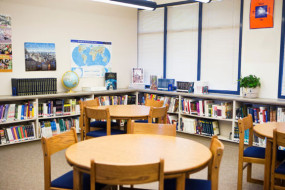
“The library is no longer a bustle of energy and students; I miss them being in here. The numbers coming to homework club are very low and the library is not the same without students!”
“The online service is working well, but it feels like the heart has gone from the library without pupils coming in.”
“The most obvious impact is the lack of face-to-face contact and the resulting drop in loans. I long for the day when the library is no longer part of a bubble and can welcome students back for library lessons and in social times.”
“The library used to have a buzz; now it feels quite lifeless with just me and one child at a time.”
“It has made the library much quieter as students can only come to the library in their bubbles. I miss the liveliness of breaktimes.”
“Operating a request service/books chosen by library staff, has in fact expanded the reading topic range for the majority of pupils.
We will continue to offer this service after things return to normal.”
Respondents shared that COVID presented an opportunity to introduce new processes or services they previously didn’t offer, and the positive outcomes of such.
“We have small, dedicated library spaces - and lots of them! Opening the main library was not possible so we switched to book orders and bubbled classroom libraries. To provide the same level of librarian support, I created a reading hub intranet which all parents and pupils can access. It has links to our reading systems, book reviews, reading tips, FAQs, competitions, and links to author websites. During a period of self-isolation for year 2 I created an interactive reading caterpillar. Every segment was a link to a free online reading resource.”
“One of the more positive impacts has been the push to look at alternative ways of working, including an investment in eBooks.”
“We have also had to change our browsing system and have had to create book boxes for each year so that books are not cross-contaminated by different bubbles. This has helped some students as the curated approach to book selection is less overwhelming for choice.”
“It has forced excellent development of some areas (YouTube, online access to catalogue etc).”
“We are very fortunate to still have the library fully open. The extra cleaning and sanitising is the only down side, but very necessary.”
Respondents shared the additional work that COVID cleaning processes, click and collect/classroom libraries, and loss of student helpers has created.
“Everything takes more time. Little things like book returns are now more time consuming with the quarantine and little irks like the Perspex around my desk means I now can't scan books! It is a slow process.”
“It has created a massive amount of extra work - student helpers can't attend and deal with daily/routine tasks and there is additional work associated with getting books to students.”
“I tried click and collect, the technical side was fine, but it took too long to sort and pack tutor boxes by myself as well as teach all Y7 reading lessons.”
Respondents shared challenges around overdue books and the extra complication quarantine adds to tracking these. They also shared of heavy losses after the first lockdown.
“Books not being returned as the library is not fully open all the time.”
“We have hundreds of overdue books!”
“We have lost a lot of our stock to students who haven't returned to school after the first lockdown - either due to leaving the school at the end of year 11 or because of COVID worries.”
“I can't keep track of overdues due to quarantine.”

Respondents identified several opportunities presented by COVID such as increase in online resource use, introducing students to books outside their normal reading habits, time to catch up on tasks, and more.
“The positive side of COVID and lockdown is that it has highlighted (and increased the use dramatically) of online resources and eBooks.”
“The positive of not having students in the library is that it gives a bit more weight to our online resources. Students are reserving a far wider selection of books than they were borrowing from shelf browsing before, specifically non-fiction.”
“Library lessons are delivered in the classroom where we choose books for students using a slip that lists their preferences. Choosing books for students lets me introduce them to authors they would not have considered but who still fit their genre preferences.”
“Cutting back on the amount of library access has given us the opportunity to reflect and plan what we want to do going forward. It has also given us the opportunity to do some housekeeping tasks like changing faded labels, etc.”
“It has been good to see the OPAC being used more effectively, and to have the opportunity to promote it.”
“I was able to carry on working through the summer term as am isolated in the library. I did a stock check, stock clearance, book tidying new labels/covers etc. and rearranged the layout to give a better flow around the room.”
“Our school Open Morning was done virtually, and the library got a slot, which a few years ago would not have happened!”
“COVID-19 meant I had to think outside the box. During lockdown I created a mobile library to ensure those wishing to read, could.”
“Lockdown gave me the time to create our library webpages with loads of info, links etc for pupils, staff, and parents.”
“On the positive side, we weeded our collection when school returned in June, and have started doing a reading audit to assess our year 7 readers, which wouldn't have happened in normal times.”
“On the plus, my technology skills have grown, I've become more imaginative, and daring in what I try to offer. I am also delving more deeply into what the LMS can offer to provide a better remote service to our community.”
“It has really shown me that I am resilient and resourceful. I have been able to adapt and become flexible, using my skill set to still ensure my students and colleagues receive the same high level library service and exciting reading for pleasure events. It is also incredible to be part of a profession that will do anything to support children's reading development, create fantastic resources, and to ensure we have a new generation of life-long readers. It was quite noticeable on Twitter. It came alive with #LibrariansInLockdown!”
The SLA is a UK focused charity which supports everyone involved in school libraries.
We believe that every pupil is entitled to effective school library provision and the educational, emotional, and developmental benefits that come with it.
The SLA is committed to supporting, promoting, and sustaining high quality reading and teaching and learning opportunities for all in a diverse and changing world.
With around 2300 members, we provide training and access to resources to support the running of school libraries and the continuing development of all library staff.
If you would like to know more about becoming a member, visit www.sla.org.uk/join